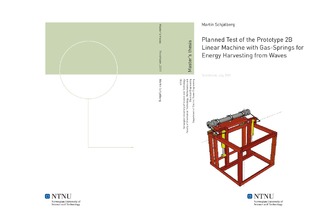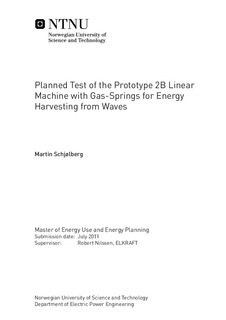| dc.contributor.advisor | Nilssen, Robert | nb_NO |
| dc.contributor.author | Schjølberg, Martin | nb_NO |
| dc.date.accessioned | 2014-12-19T13:53:03Z | |
| dc.date.available | 2014-12-19T13:53:03Z | |
| dc.date.created | 2011-12-04 | nb_NO |
| dc.date.issued | 2011 | nb_NO |
| dc.identifier | 461492 | nb_NO |
| dc.identifier | ntnudaim:6088 | nb_NO |
| dc.identifier.uri | http://hdl.handle.net/11250/257199 | |
| dc.description.abstract | This paper describes a proposed test plan for harvesting energy from waves with a linear machine that uses gas-springs. The linear machine Prototype 2B has been put into production and will be finished. The machine has been constructed to withstand 300 bars of gas pressure and the maximum speed of the rotor is set to 10 m/s due to the sealing. The model made in [5] uses the fundamental equations and describes the system behavior of a linear machine with gas springs. The model has been slightly improved and the input specifications for the Prototype 2B have been used. The simulations shows that one needs to feed electric energy in some parts of the cycle, but the whole cycle will yield a positive net contribution of electrical energy. The model is not optimized, and hence should be improved due to the time consuming simulations. Steel profiles have been proposed to use for the frame of the test-bench. The first draft of the drawing has been sent to NTNU and the workers have started to build the frame. To ensure the vibration energy to spread itself into the surroundings, isolators need to be selected and adapted. The natural frequency of the test bench with four chosen isolators was calculated to 18,17Hz. The chosen isolators are therefore most likely good enough since the lowest operating frequency of the machine was simulated to 55 Hz.Transferring the energy from the high-force-low-speed source (the wave) to the resonator has been discussed and some suggestions have been proposed. The energy transfer is done by raising pressure in a freestanding actuator with a hose connected to the gas spring. Hence, increasing the actuator pressure will increase the gas spring pressure and the force acting on the rotor will be significantly higher. A procedure to select the correct components are discussed and a Matlab script for analyzing the choice has been made. The high-force-low-speed source has been discussed. Two solutions where a hydraulic system is used have been further investigated, and some calculations and analysis have been performed. Simulations show that one need to apply a maximum force of 24115N at one actuator with a 32mm effective piston area. The regulation of the high-force-low-speed source could be crucial to obtain a good test result since the regulation of the wave must adapt itself to the resonating force of the rotor. The regulation must therefore be investigated further as it can have tremendous impact on the possibility of extracting energy from the machine.The electrical source and regulation control have been discussed. Timing of the electrical energy supplied is crucial and three operational simulations have been performed to investigate when the positive net contribution is at it`s highest. In order to extract the maximum possible net energy from the machine, the right electrical control is very important to implement. Two of the control systems have been proposed, where perhaps the simple proportional controller should be chosen to prove the concept. Later on a more sophisticated electrical controller should be applied since the efficiency of the wave energy converter could increase significantly.The non-linear compression event in the gas-springs is not proportional to the electrical extracted energy. Simulations show that when the pressure increases in the springs one could extract more energy, but the non-linear event could not be recognized. Simulations show that the efficiency of the system varies significantly with the controlling of the machine. If a simple proportional controller is adapted, the theoretical efficiency becomes 2,87% and with a more sophisticated controller one could get 10,02%. This means that there must be done more research on the electrical operating control system if energy harvesting could be profitable. | nb_NO |
| dc.language | eng | nb_NO |
| dc.publisher | Institutt for elkraftteknikk | nb_NO |
| dc.subject | ntnudaim:6088 | no_NO |
| dc.subject | MTENERG energi og miljø | no_NO |
| dc.subject | Energibruk og energiplanlegging | no_NO |
| dc.title | Planned Test of the Prototype 2B Linear Machine with Gas-Springs for Energy Harvesting from Waves | nb_NO |
| dc.type | Master thesis | nb_NO |
| dc.source.pagenumber | 46 | nb_NO |
| dc.contributor.department | Norges teknisk-naturvitenskapelige universitet, Fakultet for informasjonsteknologi, matematikk og elektroteknikk, Institutt for elkraftteknikk | nb_NO |

